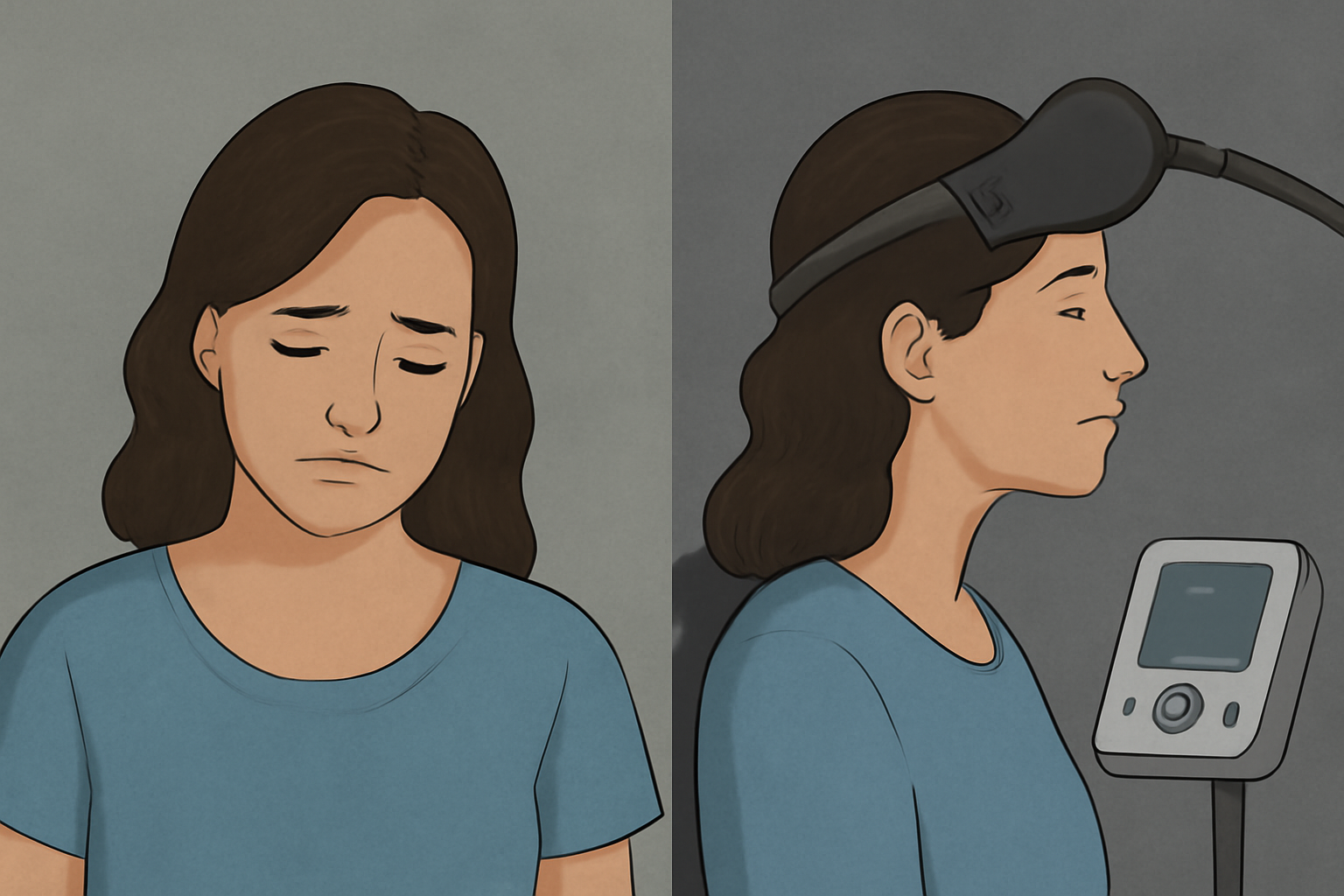TMS therapy has emerged as a groundbreaking treatment for individuals struggling with treatment-resistant depression and other mental health conditions. This comprehensive article provides a detailed overview of what to expect before and after TMS therapy, examining how this innovative treatment works, the brain changes that occur during the process, and the long-term benefits patients can experience.
Understanding How TMS Therapy Works
Transcranial Magnetic Stimulation (TMS) represents a significant advancement in mental health treatment. This non-invasive procedure uses powerful magnetic pulses to stimulate specific areas of the brain involved in mood regulation. The treatment targets the prefrontal cortex, a brain region that plays a central role in emotional processing and decision-making.
The magnetic field generated during TMS therapy is similar in strength to an MRI machine. These magnetic pulses create small electrical currents in the targeted brain tissue, helping to restore normal neural activity patterns. Unlike other brain stimulation treatments, TMS does not require anesthesia or sedation, making it an attractive option for many patients.
Before TMS Therapy: Preparing for the Treatment
Initial Consultation and Evaluation
The process of understanding before and after TMS therapy begins with a comprehensive evaluation by a qualified mental health professional. During this initial consultation, doctors review the patient’s medical history, current medications, and previous treatment experiences.
Patients typically undergo psychological assessments to determine if they meet the criteria for TMS therapy. This evaluation includes discussing symptoms, treatment history, and specific goals for the therapy. Doctors also conduct physical examinations to ensure patients are suitable candidates for magnetic stimulation treatment.
The consultation process helps establish realistic expectations for what patients can expect before and after TMS therapy. Medical professionals explain the treatment schedule, potential side effects, and timeline for seeing results.
What Happens Before TMS Therapy Begins?
Before starting TMS therapy, patients receive detailed instructions about preparing for treatment sessions. This preparation phase includes:
- Reviewing medications that might interfere with treatment
- Discussing any metal implants or medical devices
- Scheduling treatment sessions around work and personal commitments
- Understanding the time commitment required for the full treatment course
Patients also receive education about the TMS process, including what the magnetic stimulation feels like and how long each session typically lasts. This preparation helps reduce anxiety and ensures patients feel comfortable proceeding with treatment.
Expectations for the First Session
The first TMS session involves mapping the brain to determine the optimal treatment location. This process, called motor threshold mapping, helps technicians identify the precise area where magnetic pulses will be delivered. The mapping process takes additional time during the first visit but ensures accurate treatment delivery.
During the initial session, patients experience the sensation of magnetic pulses for the first time. Most describe the feeling as a tapping sensation on the scalp, similar to a woodpecker pecking. While the sensation may feel unusual initially, most patients quickly adapt to it.

TMS Therapy in Action: What Happens During Treatment?
The TMS Procedure
Each TMS therapy session follows a structured protocol designed to deliver consistent, therapeutic magnetic stimulation. Patients sit comfortably in a specialized chair while a trained technician positions the magnetic coil against their scalp.
The treatment device delivers magnetic pulses in specific patterns, alternating between periods of stimulation and rest. These patterns are carefully calibrated based on research showing optimal therapeutic effectiveness for different conditions.
What to Expect During a Session
A typical TMS session lasts approximately 20-40 minutes, depending on the specific protocol being used. Patients remain awake and alert throughout the entire treatment, able to read, listen to music, or engage in quiet conversation.
The magnetic pulses create a rhythmic tapping sensation and produce audible clicking sounds. Patients wear earplugs to protect their hearing from the noise generated by the magnetic coil activation.
Most patients find TMS sessions comfortable and report minimal disruption to their daily routines. The non-invasive nature of the treatment allows patients to drive themselves to and from appointments and return to normal activities immediately after each session.
Brain Before and After TMS: How TMS Affects Brain Activity
Brain Before TMS Therapy
Brain imaging studies reveal distinct patterns of neural activity in individuals with depression and other mood disorders. The brain before and after TMS shows significant differences in key regions responsible for emotional regulation.
Before treatment, brain scans typically show reduced activity in the left prefrontal cortex, an area associated with positive emotions and motivation. This underactivity contributes to the persistent negative thoughts and feelings characteristic of depression.
Neuroimaging also reveals altered connectivity between different brain regions, disrupting the normal communication networks that regulate mood, attention, and decision-making processes.
Brain After TMS Therapy
The TMS brain before and after comparison shows remarkable changes in neural activity patterns following successful treatment. Brain imaging studies demonstrate increased activity in previously underactive regions, particularly the left prefrontal cortex.
TMS therapy appears to strengthen neural connections and improve communication between brain regions involved in mood regulation. These changes help restore more balanced brain activity patterns associated with improved mental health.
Research using functional MRI scans has documented lasting changes in brain activity that correspond with symptom improvement. These neuroplasticity changes suggest that TMS therapy creates genuine biological improvements rather than temporary symptom relief.
After TMS Therapy: Expected Results and Improvements
Immediate Post-Treatment Effects
The period immediately after TMS therapy varies among patients, with some experiencing rapid improvements while others notice gradual changes over several weeks. Common immediate effects include:
- Mild scalp tenderness at the treatment site
- Temporary headaches that typically resolve quickly
- Slight fatigue following the first few sessions
- Gradual improvements in mood and energy levels
Most side effects are minimal and resolve within hours of treatment completion. Serious adverse effects are rare, making TMS therapy a well-tolerated treatment option for most patients.
Long-Term Benefits of TMS Therapy
Studies examining TMS before and after outcomes show sustained improvements in depression symptoms for many patients. Long-term benefits often include:
- Significant reduction in depressive symptoms
- Improved sleep quality and energy levels
- Enhanced cognitive function and concentration
- Better emotional regulation and stress management
- Increased motivation and interest in activities
- Improved quality of life and social functioning
When Do Patients See Results?
The timeline for seeing results varies considerably among individuals. Some patients notice improvements within the first few weeks of treatment, while others require the full treatment course before experiencing significant benefits.
Most clinical protocols involve 20-36 sessions delivered over 4-6 weeks. Peak benefits typically occur 2-4 weeks after completing the full treatment course, as the brain continues to adapt and strengthen new neural pathways.
TMS Therapy vs Other Treatments: Comparing Effectiveness
TMS vs Medication
When comparing before and after TMS therapy results with traditional antidepressant medications, TMS offers several distinct advantages. Unlike medications that affect the entire body, TMS targets specific brain regions without causing systemic side effects.
Patients who have not responded to multiple medications often find TMS therapy effective when other treatments have failed. The absence of sexual side effects, weight gain, and cognitive dulling makes TMS particularly appealing to many patients.
TMS vs Electroconvulsive Therapy (ECT)
TMS therapy provides a less invasive alternative to electroconvulsive therapy for treatment-resistant depression. While ECT requires anesthesia and can cause memory loss, TMS allows patients to remain conscious and experience minimal cognitive side effects.
The outpatient nature of TMS treatment makes it more accessible and convenient than ECT, which requires hospital admission and recovery time after each session.

Monitoring Progress and Maintaining Results
Tracking Progress During and After TMS Therapy
Healthcare providers use standardized depression rating scales to monitor patient progress throughout the treatment course. These assessments help track improvements and adjust treatment protocols as needed.
Regular evaluations allow doctors to identify patients who are responding well to treatment and those who might benefit from protocol modifications or additional sessions.
Maintenance After TMS Therapy
Most patients who respond well to initial TMS treatment maintain their improvements for extended periods without additional intervention. However, some individuals may benefit from periodic maintenance sessions to sustain their therapeutic gains.
The need for maintenance treatment varies among patients and depends on factors such as the severity of their condition, response to initial treatment, and individual brain chemistry. Healthcare providers work with patients to develop personalized maintenance plans when necessary.
The Transformative Potential of TMS Therapy
Before and after TMS therapy, patients often describe feeling like they have reclaimed their lives from the grip of treatment-resistant depression. This innovative treatment offers hope to individuals who have struggled with conventional therapies, providing a non-invasive path to mental wellness.
The evidence supporting TMS therapy continues to grow, with research demonstrating its effectiveness for depression, anxiety, and other mental health conditions. As our understanding of brain plasticity advances, TMS therapy represents a promising approach to healing that works with the brain’s natural ability to adapt and recover.
For individuals considering TMS therapy, understanding what to expect before and after TMS therapy helps inform treatment decisions and set realistic expectations. This groundbreaking treatment offers new possibilities for achieving lasting mental health improvements without the side effects associated with traditional interventions.
